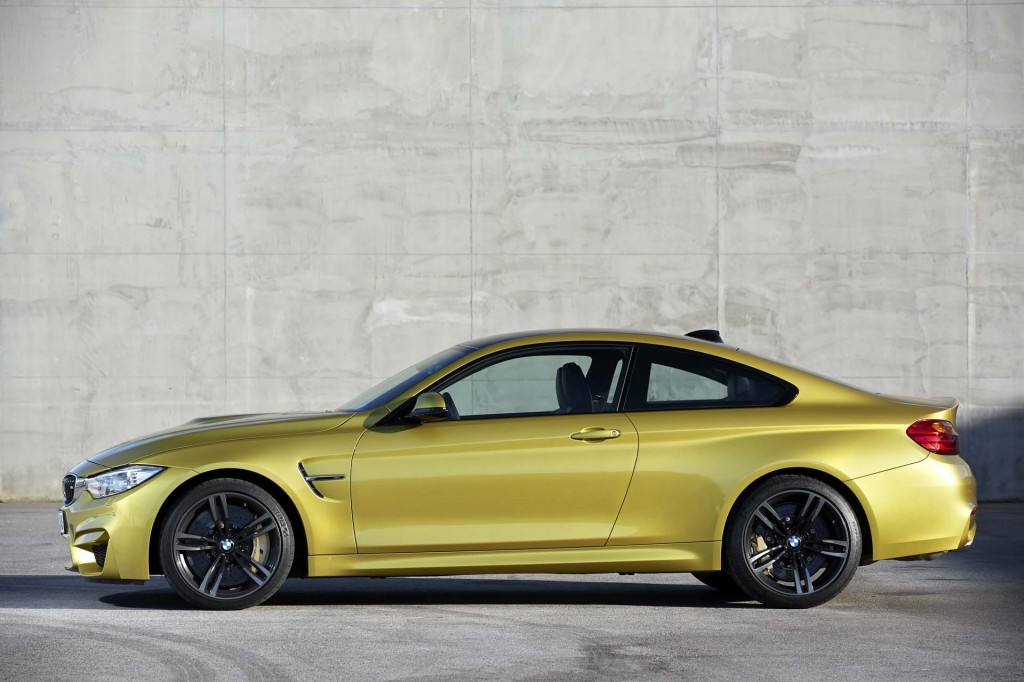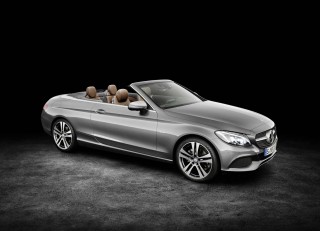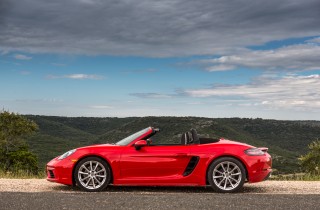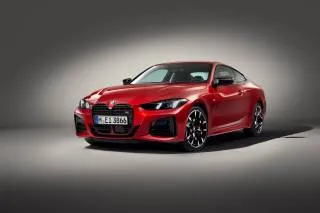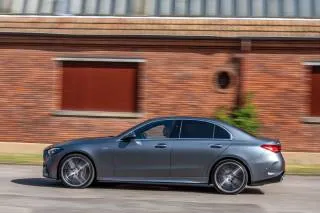Likes
- Twin-turbo inline-6 can rev for days
- Available optional paint colors can be stunning
- Demands perfection...
- ...and rewards it
Dislikes
- Engine wail isn't wholly satisfying
- Drop-top version is $8,500 more
- Rearview camera is buried in needlessly expensive package
- Competition package doesn't have value on paper
Buying tip
features & specs
The 2017 BMW M4 is a near-perfect performance coupe that can be hugely rewarding to competent drivers.
It may not be a household name within the BMW lineup, but the 4-Series really isn't anything new. A couple of years ago, BMW spun off its 3-Series coupes and convertibles as the rebranded 4-Series in an effort to capitalize on their more "lifestyle" appeal up against the comparatively workaday 3-Series sedan and wagon.
Dig into the details and the 3s and 4s are pretty much the same thing underneath, but the 4-Series offers more choice and cuts a decidedly more interesting shape. We've scored it a 6.6 out of 10, docking it somewhat for its questionable value at all levels and a look that's frumpier than what rivals offer up. Still, there's a lot to like here, even if some of that traditional BMW magic seems to be gone. (Read more about how we rate cars.)
For 2017, the 4-Series lineup sees new engines underhood with new nameplates to match: 428i becomes 430i and 435i becomes 440i. The 4-Series is again offered as a coupe, a convertible with a folding metal roof, and a five-door hatchback badged the Grand Coupe. It's the last one that's our favorite for the way it takes 3- and 4-Series virtues and puts them into an especially unique package.
BMW 4-Series styling and performance
With the 4-Series, BMW tweaked the design of the 3-Series in ways that wouldn't quite work in the sedan—to bring out some of the same proportions of the long-ago 8-Series, as well as some of the styling cues of former generations of 3-Series coupes. The 4-Series has a somewhat wider, broadened look and some bolder cues, with a lot more "negative" space in front. Despite it all, the 4-Series actually works extraordinarily well in profile. It has a perfect balance of glass to metal, a decathlete stance (especially from the rear quarters), and some spot-on details, like its sharply creased shoulder line. And the cabin's slightly more adventurous, with some sweeping arcs and trim packages that lift its basic-black wardrobe into something a little more couture.
While the 3-Series lineup saw a mild nip-and-tuck to mark 2017, the 4-Series waits for most of its styling updates to come next year as a 2018.
Underhood, the 4-Series discards last years 4- and 6-cylinder turbo engines for what at first sounds like more of the same—4- and 6-cylinder turbo engines. But there's more power now. The 430i's 2.0-liter makes 248 horsepower and 258 pound-feet of torque, while the 440i checks in with 320 hp and 330 pound-feet from a 3.0-liter turbo-6.
With either engine, you can get rear-wheel drive or all-wheel drive; and, yes, you can even get all-wheel drive on the Convertible. On coupes, a 6-speed manual is standard on rear-drive models and the 440i xDrive, while the 8-speed that's optional there is standard on the 430i xDrive. Enthusiasts will no doubt lament that the 8-speed automatic is the only option on the convertible and the Gran Coupe.
It's worth noting that the 4-Series shares much of its body with the hot-rod M4, but at a more accessible price point.
BMW 4-Series comfort, safety, and features
The entire 4-Series lineup makes good on many counts: ride comfort, a hushed cockpit, and plenty of options for customization. On the flip side, the coupes and especially convertibles don't offer much rear seat or cargo space and all models see their price tags escalate rapidly.
And don't forget about the 4-Series Convertible. With a folding hardtop that can lower or raise itself in 20 seconds, at speeds of up to 11 mph. BMW fitted the folded roof more effectively into the trunk, retaining up to 7.8 cubic feet of storage space when the top is down (or 13 cubic feet when up). A fold-down rear seat extends the usefulness of the trunk—and on the less practical side, BMW also fits a standard windblock, three-setting neck warmers, and more sound-deadening materials for a longer driving season and for a quieter ride than in the old 3-Series Convertible.
Crash-test ratings are still an open question as neither the IIHS nor the NHTSA has subjected any version of the 4 to their testing. That said, the 3-Series range generally performs well—and, like its sedan sibling, the 4-Series offers a wide range of safety tech like automatic emergency braking, albeit for a price.
Just as it does on the 3-Series sedans and wagons and hatchbacks, BMW groups the 4-Series into trim lines also, giving buyers a choice of base, M Sport, Sport, and Luxury themes.
Base models are decently equipped, but not opulently outfitted. You're sitting on vinyl seats that aren't power and there's no backup camera, for instance.
The Sport line replaces the Luxury line's chrome with high-gloss black exterior cues, red-stitched leather in the interior, and red highlights in the instrument cluster, among other upgrades. And the M Sport line gets a unique M aerodynamic kit, an optional exclusive Estoril blue exterior color, Shadowline exterior accents, an anthracite headliner, sport seats, and an M-themed appearance.
Sport Line trim is standard across all models, with the sport seats, Anthracite headliner, sport leather steering wheel, and chrono-scaled instrument cluster.
Particularly desirable is the Track Package with its adaptive suspension and uprated brakes.
The thriftiest 4-Series is the rear-drive 430i coupe with the optional automatic at 23 mpg city, 34 highway, 27 combined. On the flip side, the 440i xDrive convertible at the opposite end of the spectrum comes in at a not terrible 20/30/24 mpg.
2017 BMW 4-Series Styling
Its coupe profile is more interesting than the 3-Series sedan, but the 4-Series looks a little frumpy against rivals.
More daring and flamboyant than the 3-Series, the 2017 BMW 4-Series lineup still comes across more staid than some of its downright sexy competition.
We've given it points above average for its interior and its exterior, which look good—but won't go down as our favorite designs ever. Still, a 7 out of 10 isn't bad by any means. (Read more about how we rate cars.)
A few years back, BMW spun its coupe range off from the 3-Series by giving it its own name, if not its own personality. The five-door Gran Touring goes a little further, even if it's nearly identical to the 3-Series sedan from some angles.
Actually BMW has tweaked the design of the 3-Series in ways that wouldn't quite work in the sedan—to bring out some of the same proportions of the long-ago 8-Series, as well as some of the styling cues of former generations of 3-Series coupes. It mostly works, but it's certainly not as bold a look as you'll find in, say, the Mercedes-Benz C-Class.
The front fascia remains its most adventurous point of the 4-Series' design. Until recently, BMWs have rigidly adhered to a certain size, shape, and manner; yet this one is a collection of massive negative spaces—more pronounced because of the low roofline.
Despite it all, the 4-Series works well in profile. It has a perfect balance of glass to metal, a decathlete stance (especially from the rear quarters), and some spot-on details, like its sharply creased shoulder line. The convertible is nearly indistinguishable, at least until its roof is dropped.
BMW's 4-Series Gran Coupe, meanwhile, seems like an oddity in the lineup until you factor in its positioning. It's significantly pricier than an equivalent 3-Series sedan and for that money you'll get a little more space inside and a little more cargo room, but perhaps more importantly, you get a sleeker profile outside.
Enthusiasts will point out that BMW was hardly first to the five-door hatchback game, but the 4-Series Gran Coupe is on its own in the U.S.—at least until Audi brings its A5 Sportback here.
Inside, the 4 mostly mirrors the 3 aside from some more interesting material and finishing choices.
Although it's not the simple performance-focused look you might expect, it's definitely a driver-oriented layout that's walled off from the passenger by those arcs of plastic and wood and metal across the center stack. It's a version of what's offered in the sedan, but the organic sweep of the cockpit works better in the coupe than in the sedan.
2017 BMW 4-Series Performance
There's still a lot of fun to be had within the 4-Series lineup, but you'll have to pick the right options.
Take the BMW 3-Series and simplify: That's what you'll get with the 2017 BMW 4-Series, which scores a 7 out of 10 on our scale.
We've rated it that way because, even though it's not as sprightly as the 3-Series coupe was once, the 4-Series remains poised and confident. (Read more about how we rate cars.)
It's a more streamlined lineup than in the 3-Series; there's no diesel, no base model 420i, and no hybrid. Instead, there are two new-for-2017 engines that offer a little more grunt than last year. One caveat: we've not spent much time behind the wheel of either, so our impressions are mostly based on last year's cars. We've driven these engines in other BMWs, however, and we'll update this space when we've had more 430i and 440i time.
Last year's 428i gives way to the 430i, which utilizes a 2.0-liter turbo-4 rated at 248 horsepower and 258 pound-feet of torque, the latter of which comes on at just 1,450 rpm. The bigger difference comes in the 440i, which boasts a 3.0-liter turbo-6 that checks in with 320 hp and 330 pound-feet from a mere 1,380 rpm. That's a healthy 20 hp boost from last year for the 6-cylinder.
On all models, only rear-wheel drive coupes offer a choice between 6-speed manual and 8-speed automatics, while convertibles and Gran Coupes offer only the latter gearbox. The optional xDrive all-wheel drive system is available on any body style, but only with the automatic.
The Driving Dynamics Control programming lets drivers tune shift points, throttle mapping, and steering response from a base level into an efficiency profile, and in either, it loafs along with rational, responsible moves. In Sport or Sport+, the steering pounces into turns, the automatic snaps off almost instantaneous shifts, the throttle zips up and down the powerband. The stability control unlocks its chastity belt.
Chassis precision
The path to that highly evolved 4-Series is clearly defined, from the way its suspension has been altered with more aluminum components and more structural stiffness than before. It still wants to be, and can be, a smooth grand tourer.
Steering is hardly a boast-worthy point in the latest 3-Series sedans; in the 4-Series, it features its own tuning for better weighting and feel. It works reasonably well with the base tire-and-wheel setup in the 430i, but with any of the larger wheel-and-tire combinations offered (up to 19 inches), the steering gets heavier than it needs to be, and that seems to negate any feel of the road, which is sorely lacking.
Based on a brief drive, we think the premium Variable Sports steering setup, that changes the rack's ratio, offers a more enthusiastic feel and better weighting overall, once you get used to the ratio changes. We also like the M Sport brakes included with that steering setup as part of the Track Package.
But if you're wistful for the 1980s or 1990s 3-Series you once had, the smaller 2-Series coupe channels that "Ultimate Driving Machine" far more accurately than the 4-Series, which has become a bit more of a boulevardier than a sports car.
2017 BMW 4-Series Comfort & Quality
Aside from its typical coupe compromises, the 4-Series doesn't quite feel worth its hefty price tag inside.
At first glance, the 2017 BMW 4-Series is exactly as it's advertised: a more evocative companion to the practical 3-Series sedans and wagons. The differences are in the details, however, as the 4-Series features some minor trim differences and some major packaging changes.
We've rated the 4-Series at 5 out of 10 points, a figure we've based on the coupe. We'd score the 4-Series Gran Touring a little higher, however, as it offers a far more capacious rear seat and a terrific cargo area. (Read more about how we rate cars.)
The coupe—and the convertible—don't exactly make great use of the 3's dimensions.
Yes, they ride on the same 110.6-inch wheelbase, and overall length of 182.6 inches, but the 4-Series' roofline is two inches lower, while it's also a half-inch wider than the sedans; and that makes a big difference in overall space.
So let's get this out of the way: The 4-Series coupe doesn't have a very useful or comfortable back seat, and it's certainly not enough for most American adults. Though it's three inches wider across the rear axle, the 4-Series still doesn't net out with much adult-sized space in the back seat, and in a tight garage its long doors don't make entry or exit very easy. For adult-sized occupants, head room might ultimately be the issue, even if those in back are willing to scrunch knees a bit. Things are even worse in the convertible, which loses space due to the way the roof needs to fold away when not in use.
In front, the seats are wonderful and the space is great for all sizes and shapes. You do sit low, gripping a steering wheel that's as thick as those in any SUV's. And a seatbelt presenter helps avoid rotator-cuff issues. The M Sport package's seats offer even more adjustability and side support without feeling truly confining.
Trunk space is almost the size of a mid-size sedan, and storage in the cabin is a brighter spot than ever, with bottle-holders in the door panels plus real cupholders capable of pleasing even the most demanding Americans ahead of the joystick-style shifter on automatic models (how did they negotiate that with the engineers?). There's also a decently sized glove box.
Convertibles are daily driver usable, as long as you consider their second row essentially kids' space. Their folding hardtop can stow or raise itself in 20 seconds at speeds of up to 11 mph, which is a little slower than cloth roof rivals. There's up to 7.8 cubic feet of storage space when the top is down (or 13 cubic feet when it's up). A fold-down rear seat extends the usefulness of the trunk—and on the less practical side, BMW also includes a standard windblock, three-setting neck warmers, and more sound-deadening materials for a longer driving season and for a quieter ride than you might expect from a convertible.
The Gran Coupe is an oddity in the lineup with its long, sloping roofline. But it's more graceful than awkward, even if its interior hardly stands out from the rest of the lineup aside from some extra rear seat and cargo space.
4-Series quality
BMW's wide, beautiful LCD screen displays crisp maps and iDrive functions, but it's also propped up the dash like a digital picture frame, something it has in common with the Mercedes CLA. Audi's A3 has a better idea: make a slide-away screen standard, so that it doesn't have to be viewed all the time.
You have a lot of flexibility in choosing interior trims for the 4-Series. Some of those basic-black interiors can seem drab and dark, and they amplify the 4-Series' sweeping dash curves in an unflattering way. So we recommend going with some of the warmer trims, as then the coupe's interior gets the sophisticated allure of the bigger 6-Series, with handsome leather and contrasting stitching, some daring colors and some very pretty wood and metal finishes.
Materials are better now than they were when the 3-Series launched a few years back, but there's still too much hard plastic on the center console and we're not impressed with the Sensatec vinyl seats that come standard. They don't imitate leather especially well. On the flip side, the 440i gains a new nappa leather-wrapped steering wheel for 2017, which feels especially nice in a driver's hands. Then again, at nearly $50,000, it ought to.
2017 BMW 4-Series Safety
The 4-Series hasn't been thoroughly tested by regulators, but the 3-Series is a decent starting point.
Though we don't have many doubts about the 4-Series' safety record, these models haven't been tested independently of the related 3-Series. With that in mind, we can't actually assign the 2017 BMW 4-Series a safety score.
Neither the federal government nor the IIHS has taken a look at these coupes, convertibles, and five-door hatchbacks yet. (Read more about how we rate cars.)
The 3-Series, on the other hand, has been improved to a Top Safety Pick+ by the IIHS for 2017. It performs better in the demanding small overlap test now than it did last year thanks to some structural modifications. Additionally, it now features better headlights—the HIDs available as an option.
The NHTSA rates the 2017 3-Series five stars overall, although it comes in at four stars for its front-crash protection.
The 4-Series offers the expected safety equipment, albeit with a few holes. All models include a full suite of airbags, stability control, adaptive brake lights, and anti-lock brakes. There's also an Automatic Collision Notification system that relays important information to emergency responders. Yet we're puzzled as to why a rearview camera is an option on the more basic models—in a model with far-from-ideal outward visibility and a price tag well above $40,000.
Options include a park-distance system, plus a surround-view camera system that has a top view and a bird's-eye view of obstacles approaching at low speeds. Full LED headlamps with automatic high beams are also available as part of a costly package. You can further opt for blind-spot monitoring, coupled with a lane-departure warning system and a camera-based collision-warning system with braking capability. Active cruise control is also offered, and it has the ability to stop the car, and to restart and carry a slow pace with traffic.
It's worth noting that the 3-Series only qualifies for the aforementioned Top Safety Pick+ award when it's ordered with LED headlamps and automatic emergency braking. If those are the only options you pick on a 4-Series, you'll be tickling $49,000—and you're still sitting on vinyl seats.
2017 BMW 4-Series Features
You won't get a lot at the low end on your 4-Series, but the sky's (nearly) the limit.
One thing BMW has long done well is offering myriad configurations for its vehicles—to that end, the 4-Series hardly disappoints.
In addition to being offered in three distinct bodystyles with two engines, two drivetrains, and two transmissions, a wide range of options are on offer. We've given the range points above average for their customizability, their option packs, and their infotainment, but we've deducted one because base models aren't exactly lavish. That brings the 4-Series to a 7 out of 10. (Read more about how we rate cars.)
Sure, you're not exactly suffering in a 430i without any options. But you're sitting on vinyl seats that are manually operated, you're not gazing at the stars through a sunroof, and you're going to have to swivel your head around to see out the back as there's no standard backup camera. It's not poverty spec, but you're also not getting into any 4-Series for much under $43,000.
BMW 440is are pretty much spec'd out like 430is aside from their more powerful engines, which cost about $6,000. Similarly, xDrives essentially mirror their rear-drive siblings, although it's worth remembering that you'll only find a (no cost) stick shift with rear-wheel drive.
Sport or luxury?
BMW offers the 4-Series in several flavors, beginning with the base configuration. From there, it's a choice of M Sport or Luxury.
The Luxury package adds upgraded leather in the cabin, a choice of three interior wood trims, unique color combinations, and exterior high-gloss chrome accents. The Sport line replaces the chrome with high-gloss black exterior cues, red-stitched leather in the interior, and red highlights in the instrument cluster, among other upgrades. The M Sport line gets a unique M aerodynamic kit, an optional exclusive Estoril blue exterior color, Shadowline exterior accents, an anthracite headliner, sport seats, and an M-themed appearance.
A recent addition to the lineup is a a Track Handling package that groups variable sport steering, uprated brakes, high performance tires, and an adaptive suspension together. It's a worthwhile option if you're looking to get the most out of your 4.
With the optional navigation system you get the latest version of BMW's iDrive, the roller-controller system that's flanked by a host of buttons, augmented by voice controls, and layered with a touch-sensitive surface on the controller letting drivers write out text such as addresses with fingertips. It comes with real-time traffic data, and can be teamed with a data subscription adding Google search capability.
Overall, iDrive is a system that's grown many layers, compared to the original, austere version that relied only on a rotary knob—and lots of spinning and clicking. It remains a maze of functionality that takes a few weeks to truly understand and customize.
2017 BMW 4-Series Fuel Economy
4-cylinder versions of the 4-Series are reasonably thrifty given their punch.
With new engines underhood, the 4-Series lineup adds a little more power but generally doesn't subtract fuel economy.
We've based our score on the rear-drive 430i, which merits a 7 out of 10 on our scale. (Read more about how we rate cars.)
That's because the automatic transmission 430i two-door checks in with a decent 23 mpg city, 34 highway, 27 combined on the recommended premium grade fuel. Opting for all-wheel drive drops those figures to 23/33/26 mpg. A manual transmission may be popular with enthusiasts, but it doesn't help the 430i in terms of efficiency; it's rated at 21/33/25 mpg.
Step up to the 440i and you'll find that the thriftiest on offer is the rear-drive automatic at 21/32/25 mpg. The manual version of that car comes in at 19/29/23 mpg, while the automatic-only xDrive rates at 21/31/25 according to the EPA.
Generally speaking, those aren't very big hits for all-wheel drive, which is commendable.
Gran Coupes score exactly the same, while convertibles come in a hair lower in most measurements due to their extra weight.
